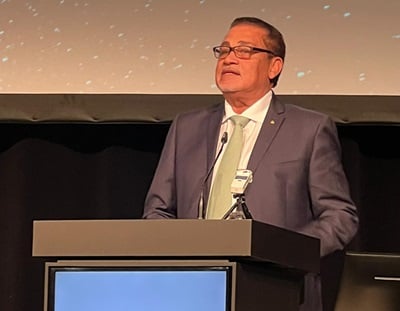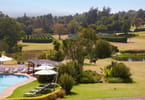“He has always had this visionary approach – he always feels in advance these big trends. He’s always interested in thinking ahead. It has been the case for the last 30 years. He likes to think ahead. That’s his wish – to have an impact, to make things happen, to change the world at his very honest and humble level.”
In today’s times of future definition through technology, one would be forgiven for thinking that these words were said to explain an innovator in the digital space – not a visionary looking at a space over 1000 years old and seeing its potential for future government and business thinkers and leaders.
This was the case, however, when Serge Pilicer, Founding President of the EITF – Les Entretiens Internationaux du Tourisme du Futur, an international tourism think tank, first viewed Château de Vixouze in Aurillac, a beautiful corner of the Auvergne-Rhône-Alpes region of France.
A now protected historic monument of the French nation (having been registered in November 2000), Château de Vixouze acts as a reflection of over one thousand years of history in the region, starting in in 930 when Bernard II, Viscount of Carlat, gives the original villa property Vixouze to the Abbey of Conques. Said to originally exist as ‘a dungeon defense and observation of the Valley of the Cere’, having survived the Middle Ages, the castle was rebuilt and reworked in the 15th, 17th and 18th centuries at the origin of great transformations. The facade was partially deconstructed to make openings, the tower adjoining staircase, the two wings and the enclosure were built. Construction of the long eighteenth building that encircles the dungeon (35 meters long), removing the second enclosure. The castle’s fountain and the porch remain standing from the 18th Century. Reflective of the times and the three great families who previously owned Vixouze, three symbols remain part of the castle’s design – a sword, a pen and the magistrate.‘
Today, this same site offers 21st Century government, corporate and leisure guests unparalleled panoramic views of the still untouched valleys of the region. Designed to host carefully selected and executed events, the castle can welcome up to 300 guests, transforming into a perfect location for uniting people from across the country, and world.
TURNING A PROTECTED PAST INTO A PRODUCTIVE FUTURE
With global tourism growing at rates of reach and yield envied by other economic sectors across the globe similarly seeking sustainable growth, unlocking new ideas for fulfilling emerging traveler wishes and wants in both the business and leisure segments, surely there are easier, more cost- and time-efficient ways of establishing a foothold in the market.
Maybe, but that’s not how a tourism visionary establishes differentiation, competitive edge, solid performance and respect.
As shared by Helene Moncorger, Pilicer’s most trusted partner:
“It’s really my husband who had the courage – his vision, his passion, his ability to think ahead. Serge created a forum twelve years ago to promote new technologies for the regional and state administration in France. A yearly rendezvous for the regional representatives to discuss infrastructure, the fact that data would be managed by computers, that computers would be a part of government running countries. He knew the perfect place to talk about the future was actually in the past. It reminds people of what is possible.”
And so, the quest for a castle began – a place that would unite leaders of the future in a way that would allow them to disconnect from the present, unlocking their ability to think big, think bold, together.
The remoteness of the region became a benefit, not, as many developers of such a project would argue, a barrier. Moncorger continues:
“A region like Cantal is not connected. But what is true today will not be true tomorrow. Coming to Cantal will be as easy as anywhere. He knew early that if the interest is there, so will be the accessibility. And the bigger opportunity for all of the people in Cantal. That will come with time.”
PLANTING THE SEEDS FOR TOURISM-INSPIRED HARVEST
Château de Vixouze is but just one example of how historical jewels can, and do, unlock opportunity for rural locales looking for a new way of shaping their future. This is especially true in traditional agricultural areas where changes in market demands mean changes in livelihoods.
Without any essential infrastructure needed to protect a tourism investment of this size and significance, establishment of Château de Vixouze went ahead. Why? Because establishing a vision starts with having a dream. In the words of Moncorger:
“It was a small boy’s dream for Serge to own a castle. Serge saw the potential long ago. It was not even for sale. It took four years of waiting to finally turn his dream into a reality. He knew that a chateau was a perfect. And he knew that making the chateau work would mean making the village work.”
To create an events venue in a small village an hour-plus flight outside of Paris would mean being responsible to, and relying on, the local community as a key stakeholder of the chateau’s operations, directly and indirectly.
A number of partners are needed, and now entrusted, to make Château de Vixouze work – caterers, florists, chefs, events companies, DJs, and more. And then there is the on-site team that keeps this historic property true to place – gardeners, security, housekeepers, business managers. Whether permanent or temporary staff, depending on time of the year, the chateau has become an economic engine in its own right.
Château de Vixouze acts as an example of turning a personal dream into a tourism-inspired and enabled reality. Especially when it comes to historical properties. Even with the challenges of advancing opportunity within a highly protected framework. Iconic assets required exceptional care. As stated by Moncorger:
“For any works on property, approval is needed as the chateau is a fully listed as National Historical Monument, inside and outside. One tree is 500 years old….”
But when the moment is right, it is right. Despite all of the reasons why such a venture may not make sense, Moncorger’s pleasure in pursuit is clear:
“I’m surprised about how easy it all works. What is amazing is how everyone feels at home and at ease here. There is a good energy. When people think middle age castle they think dark, cold. But when they enter they feel inspired, the history, the character – it all makes people ‘be here’.”
Making it work may mean making 21st century adjustments – underfloor heating, Wi-Fi, exterior lighting, parking, sound systems, professional kitchens and events spaces.
More importantly, it takes vision to recognize the value of the asset is about the value it imparts on its surrounds.
Yesterday, today, tomorrow, there is no greater economic and social force for good that Tourism to connect our world – past, present and future.
SEO U LOKELANG HO SE NKA HO SEHLOOHO ENA:
- A now protected historic monument of the French nation (having been registered in November 2000), Château de Vixouze acts as a reflection of over one thousand years of history in the region, starting in in 930 when Bernard II, Viscount of Carlat, gives the original villa property Vixouze to the Abbey of Conques.
- In today's times of future definition through technology, one would be forgiven for thinking that these words were said to explain an innovator in the digital space – not a visionary looking at a space over 1000 years old and seeing its potential for future government and business thinkers and leaders.
- And so, the quest for a castle began – a place that would unite leaders of the future in a way that would allow them to disconnect from the present, unlocking their ability to think big, think bold, together.























